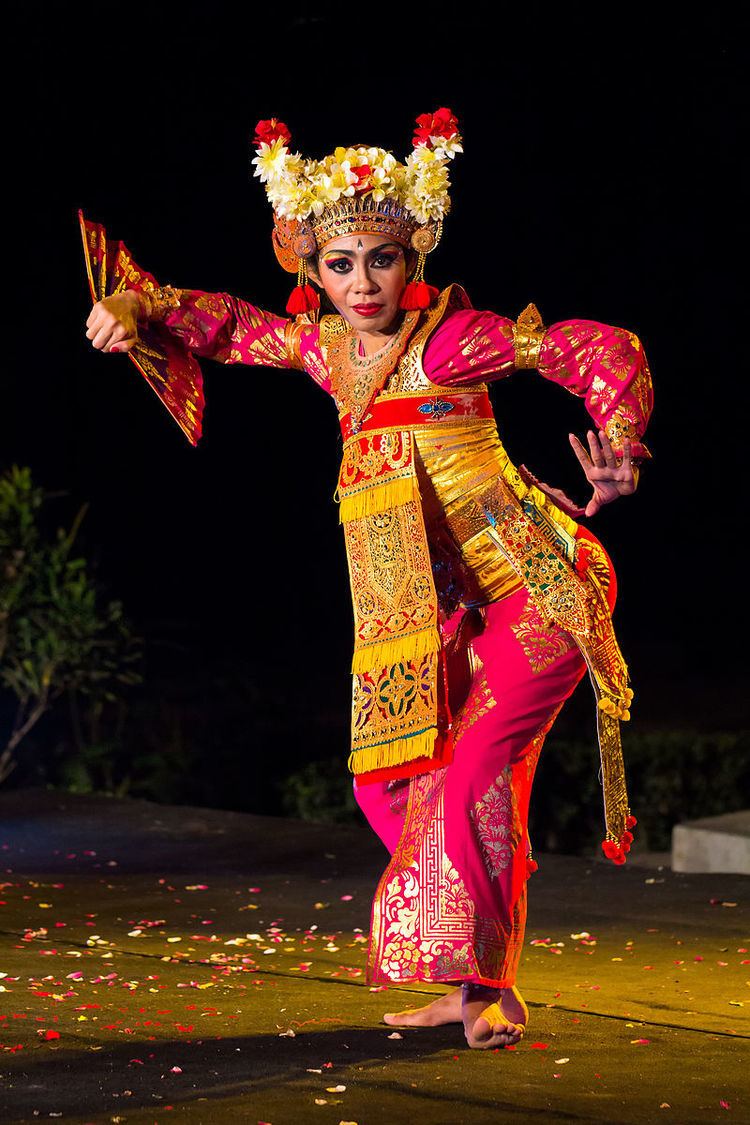 | ||
Balinese dance is a very ancient dance tradition that is part of the religious and artistic expression among the Balinese people of Bali island, Indonesia. Balinese dance is dynamic, angular and intensely expressive. Balinese dancers express the stories of dance-drama through the bodily gestures including gestures of fingers, hands, head and eyes.
Contents
There is a great richness of dance forms and styles in Bali; and particularly notable are those ritualistic dance dramas which involve Rangda, the witch, and the great beast Barong. Most of dances in Bali are connected to Hindu rituals, such as the Sanghyang Dedari sacred dance than invoked hyang spirits that believed to possess the dancers in trance state during the performance. Other Balinese dances are not linked to religious rituals and created for certain purposes, such as Pendet welcoming dance and Joged dance that is social dance for entertainment purpose.
Recognition and conservation
During the Intergovernmental Committee for the Safeguarding of the Intangible Cultural Heritage convention in 29 November to 4 December 2015 in Windhoek, Namibia, UNESCO recognizes three genres of traditional dance in Bali, Indonesia, as Intangible cultural heritage. The three genres includes Wali (sacred dances), Bebali (semi-sacred dances) and Balih-balihan (dances for entertainment purposes). The Balinese dance has been proposed since 2011, and officially recognized in 2015.
The three genres are represented by nine dances, which describes its function and living tradition in Balinese community, they are:
- Rejang (Klungkung District). Sacred ceremonial dance by a young women in traditional ceremonial dress,
- Sanghyang Dedari (Karangasem District). Sacred trance dance to counteract negative supernatural forces. Performed by two young girls.
- Baris Upacara (Bangli District) religious dances conveying heroic spirit danced by even numbers of male dancers.
- Topeng Sidhakarya/Topeng Pajegan (Tabanan District). Performed by masked dancers to neutralize the evil spirits.
- Gambuh dance drama (Gianyar District). Formerly royal theatrical performance, now accompaniment to ceremonies, by 25-40 dancers.
- Wayang Wong dance drama (Buleleng District). Combines dance, epic drama and music.
- Legong Kraton (Denpasar City). Exquisitely beautiful dance by 2 or 3 girls. Developed from Sanghyang Dedari, and Gambuh.
- Joged Bumbung (Jembrana District). A popular social dance by couples, during harvest season or on important days.
- Barong Ket "Kuntisraya" (Badung District). Represents a fight between two mythological characters, Barong in the form of a lion symbolizing goodness and Rangda, an evil witch.
Significance
In Hinduism, dance is an accompaniment to the perpetual dissolving and reforming of the world. The creative and reproductive balance is often personified as Shiva's wife, Durga, sometimes called Uma, Parvati, or Kali. This has significance in Balinese Hinduism, since the common figure of Rangda is similar in many ways to Durga.
Variants
In Bali there are various categories of dance, including epic performances such as the omnipresent Mahabharata and Ramayana. Certain ceremonies at village temples feature a special performance of a dance-drama, a battle between the mythical characters Rangda, the witch representing evil, and Barong, the lion or dragon, representing good.
Among the dance traditions in Bali, the following deserve special mention:
Technique
Bali dancers learn the craft as children and even in the womb they are played Balinese music. They are taught to dance with their hands before they can walk. Official training as a Bali dancer starts as young as 7. In Balinese dance the movement is closely associated with the rhythms produced by the gamelan, a musical ensemble specific to Java and Bali. Multiple levels of articulations in the face, eyes, hands, arms, hips, and feet are coordinated to reflect layers of percussive sounds.
The number of codified hand positions and gestures, the mudras, is higher in India than in Java or Bali. It has been speculated that they have been forgotten as the dance was transmitted from India to Java. Hand positions and gestures are nonetheless as important in Javanese and Balinese dance as in India. Whether in India, Indonesia or Cambodia, hands have a typically ornamental role and emphasize the dance's delicate intricacy.
